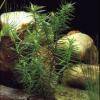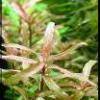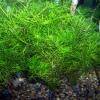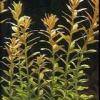Rotala macrandra
Scientific name: Rotala macrandra
Family: Lythraceae
Maximum size reached under cultivation: 25 - 55 cm (9.84 - 21.65 inch)
014
Recommended pH range: 6 - 6.9
Recommended water hardness: 4 - 12°dGH (71.43 - 214.29ppm)
0°C 32°F30°C 86°F
Recommended temperature range: 22 - 25 °C (71.6 - 77°F)
Preferred propagation method: Cuttings
Native to: Sri Lanka
Growth rate: Fast
Recommended substrate: Fine gravel
Lighting requirements: Bright
Ideal placement in tank: Midground
Common Name
Giant Red Rotala
Scientific Name
Rotala macrandra
Family
Lythraceae
Origin
Rotala macrandra is native to Asia, specifically from India and Sri Lanka, where it thrives in the warm, shallow waters of marshes, paddy fields, and slow-moving streams. Its natural habitat provides the high light and nutrient-rich conditions that this plant requires to flourish in aquariums.
Usual Maximum Size
In aquariums, Rotala macrandra can reach a height of 25 - 55 cm (9.84 - 21.65 inches), making it ideal for midground or background placement depending on the aquascape design and the size of the tank.
Planting Area
Due to its height and stunning coloration, Rotala macrandra is best suited for the midground or background of the aquarium. Its vibrant red leaves provide a striking contrast to green plants, adding visual interest and depth to the aquascape.
Propagation
Rotala macrandra is propagated through stem cuttings. To propagate, prune the mother plant and keep the cuttings. Remove the leaves from the bottom inch of the cutting to reveal a bare stem, then carefully plant the stem into the substrate, taking care not to crush it. Within a short period, roots will develop at the first node, establishing a new plant. Regular pruning encourages bushier growth and prevents the lower leaves from dying off due to lack of light.
Growth Rate
This species is known for its fast growth rate when provided with optimal conditions, including bright lighting and sufficient nutrients. Regular trimming is necessary to maintain its shape and promote healthy growth.
Lighting Requirements
Rotala macrandra demands bright lighting to maintain its vibrant red coloration and healthy growth. Insufficient light can lead to a faded color and stunted growth. LED lights or fluorescent tubes that provide intense lighting are ideal for this plant. A minimum of 0.5 watts per liter (2 watts per gallon) is recommended for proper growth. In addition, avoid shading the plant with taller species to ensure it receives adequate light.
Substrate
This plant thrives in fine gravel or nutrient-rich substrates. Adding root tabs or a nutrient layer beneath the substrate can enhance its growth and coloration. Since Rotala macrandra absorbs nutrients through both its roots and leaves, providing a balanced fertilization regimen is crucial for its health.
Water Conditions
pH: Rotala macrandra prefers slightly acidic water with a pH range of 6 to 6.9.
Hardness: It grows best in soft to moderately hard water, with a recommended hardness of 4 - 12°N (71.43 - 214.29 ppm).
Temperature: The ideal temperature range for this plant is 22 - 25°C (71.6 - 77°F). Maintaining stable water parameters is key to preventing stress and promoting lush growth.
CO2 and Nutrients
Rotala macrandra benefits significantly from supplemental CO2 injection. The addition of CO2 not only accelerates growth but also helps maintain the plant's intense red color. Regular dosing with liquid fertilizers containing micronutrients like iron and potassium is also essential. For optimal results, the nitrate levels in the water should be kept between 10-25 ppm.
Difficulty
This plant is considered medium in difficulty. While it is not the easiest plant to grow, aquarists who can provide high light, CO2 supplementation, and a nutrient-rich environment will be rewarded with a lush, red plant that adds an eye-catching element to the aquascape.
Short Description
Rotala macrandra is a stunning, fast-growing stem plant that is popular among aquarists for its striking red coloration. It requires bright lighting, CO2 supplementation, and nutrient-rich water to thrive. Its delicate leaves make it sensitive to changes in water conditions, but with proper care, it adds an unparalleled beauty to any planted aquarium. Avoid planting the stems too close together to ensure that the lower leaves receive enough light, preventing them from dying off. When cared for correctly, Rotala macrandra becomes a vibrant centerpiece in the aquascape.

 Ammania gracilis
Ammania gracilis Ammania senegalensis
Ammania senegalensis Didiplis diandra
Didiplis diandra Nesaea crassicaulis
Nesaea crassicaulis Rotala indica
Rotala indica Rotala nanjenshan
Rotala nanjenshan Rotala rotundifolia
Rotala rotundifolia Rotala wallichii
Rotala wallichii